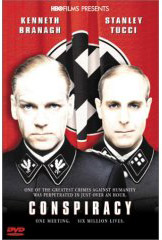 The Hunt for John Wilkes Booth (History Channel, 2007)
The Hunt for John Wilkes Booth (History Channel, 2007)
This two-hour documentary is based on the Michael Kauffman book, American Brutus: John Wilkes Booth and the Lincoln Conspiracies, and is another solid presentation by The History Channel. It is both educational and entertaining. The events following Lincoln’s death along with the thrilling 12-day manhunt for Booth and his conspirators makes for an exciting yarn. I like today’s trend of using reenactments within the documentary to provide a kind of doc-u-drama presentation. The total production from the score to the digital presentation is crisp and clean. I highly recommend that you add this to your educational library.
 Conspiracy (2001) – Starring: Clare Bullus, Kenneth Branagh Director: Frank Pierson Rating: R. (Rated for some language, no violence or nudity)
Conspiracy (2001) – Starring: Clare Bullus, Kenneth Branagh Director: Frank Pierson Rating: R. (Rated for some language, no violence or nudity)
One of the more eery, haunting and mesmerizing historically based movies I have seen. Based on the only surviving record of the The Wannsee Conference of 1942, this film brilliantly captures the disturbing ethos of Nazism in all its horrifying elements. in the winter of 1942, Himmler’s second in command of the SS, Reinhard Heydrich, held the conference in Berlin with 15 top Nazi officials in order to coordinate the “Final Solution” (Endlösung) — the extermination the entire Jewish race in Europe. This slow, but deliberated paced movie still captures your attention and holds it through-out. The plain and matter-of-fact discussion on the part of the Nazi’s concerning exterminating the Jews takes place with laughter, wine, and Hors d’oeuvre, and this is impacting as it highlights an atmosphere that we today could never understand. This is another must have for the educational toolbox, especially if you teach 20th Century or any modern European history class.
 Why We Fight (2006) – Director: Eugene Jarecki Rating: PG-13.
Why We Fight (2006) – Director: Eugene Jarecki Rating: PG-13.
This presentation, though leaning left, still manages to present a very thought-provoking documentary on the motivations and reasons for why the United States has become a kind of, “world police.” The narrative wants to lead you down a path and toward its desired end, but still it does allow alternative ideas to be expressed. But in the end, you cannot help but walk away with a dominant, “America is the problem” view of the world; which is disappointing. If you are to show this video in your classroom, you have to stop it at various points and discuss what is being said, and why.
From an isolationist nation at the end of WWI, the U.S. today has bases in over ninety countries. No other nation has been able to project military power as the U.S. does today. Yet, some argue, we really do not attempt to influence the world on a level anywhere close to past empires. When we fight today, we rarely use all of our resources; not that we wouldn’t, but that we couldn’t. On the other hand, some argue that we influence the world tremendously and do so in such a way that events like 9/11, though a surprise to most Americans, are not a surprise when you look at what our government does and the concept of “blow-back.”
If we were to discuss this topic (Why We Fight) within the two above viewpoints, what arises is: complication, uncertainty, and confusion. Each side presenting a very different view than the other. The truth is probably somewhere in the middle, but is rarely presented like that from either right or left.
When I teach the 20th Century to my U.S. History students, in an effort to explain our position today, I go back and step-by-step look at U.S. policy: Isolationism; Truman Doctrine, Marshall Plan, Containment, Carter Doctrine, ect. Everything evolves from these and other policies. You take one or two views, and twist them or do not present all aspects, you do a disservice to history.
I do wish Gore Vidal was not in this video, here is a man who is not a historian but an activist and novelist, at best. He lives in a world of fiction. How you use his assessment of WW2 and the dropping of the nuclear bombs, without properly presenting alternative viewpoints, hurts this documentary greatly. As a matter of fact, there is little balance on other issues as well. As for the Cold War, according to this video, we were the main problem. Additionally, the doc shows clips from actual U.S. propaganda films from post-WW2. Films that would make anyone cringe and blush today. Yet to simply show these clips without attempting to explain the environment that created them and WHY, is irresponsible, yet some (including educators) have no problem doing so.
“Presentism” has to be avoided. Whether we like it or not, there were threats that people believed in, legitimate ones, and those to the highest levels. The Cold War was a product of its environment and WW2 where Fascist and Totalitarian regimes plunged the world into the most devastating destruction by the hands of man ever seen, and one created by many forces. This is not at all addressed in the film, and perhaps there is not time. Instead, as noted, you have this underlining “America” is bad presentation. The problem is far more complex than this presentation suggests.
YET! this is still a documentary that you need to show. It gets to the heart of “Why We Fight,” regardless for how flawed it might be. There is a military industrial complex within our country that is out of control! There is a legit connection between our current Vice President and that military establishment. There are connections between current congressmen and women and that military establishment. We need to be more aware of this as a nation of voters.
This movie can be a great discussion tool with proper balancing. Also, within this narrative the filmmakers descend on average Americans and within short interview clips, we see how people truly don’t understand the forces involved. Yes, another reason to talk about it.
This film tells several stories. From the growing and expanding military industry from WW2 and through-out the Cold War. While doing so, it also tells of the increasing influence within the government and congress in allowing this military industry to control and shape national policies.
Though I do not agree with some aspects, Why We Fight brings us to some places that we as American’s have to consider, as already noted, the American Military Complex that Eisenhower warned us about is truly here. The weapons of warfare dominate Congress and American policy at the worst, and at best, heavily influence policy.
You can actually watch this entire documentary online here.
Chris – I agree…the “Hunt for Booth” is a great documentary…I first caught it on the History Channel over the holidays last year and had been eagerly waiting for its arrival on DVD, which I obtained the day it was released.
When I first saw it on TV, I was amazed that they featured a fellow by thename of “Michael Kauffman” rather than James Swanson…now I know why…I have just finished Kaufmann’s “American Brutus” and found it superior to Swanson’s “Manhunt.” (I enjoyed Steers’ “Blood on the Moon” very much also), esp. in terms of annotation and scholarship.
Keep up the great work,
Jim Schmidt
Jim I agree with you 100% on Kauffman.
C
I showed “Conspiracy” to a high school class for an elective on World War II. The students found it very absorbing, and disturbing. I thought I read somewhere that the conference on film took the same amount of time as the actual conference. I believe there was an German language version as well.
A lesser known suggestion would be “A Soldier’s Story,” about the murder of a black army sergeant in Louisiana in 1944. It’s good on the segregated military, the Negro baseball leagues and different ways of being black, or any minority, in the United States. It’s also about the insidious nature of evil and racism, summed up when a character says thoughtfully to one of his victims, “Them Nazis ain’t all crazy.”
Matt, good suggestion on “A Soldier’s Story,” which indeed is a great film for that issue. I have seen it. It’s also good to know how your class respondede to “Conspiracy,” something to think about. Was it an AP or college placement class or standard history class?
C
It was a standard history class. Actually I teach students with social and emotional disabilities, which sounds difficult, but the students’ academic ability is typical of regular high school classes. My students often have an more informed viewpoint on certain issues.